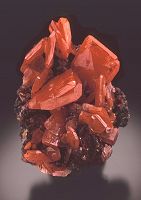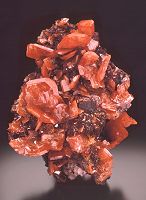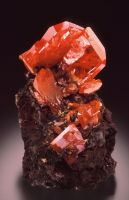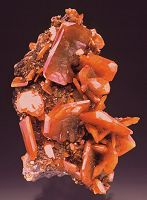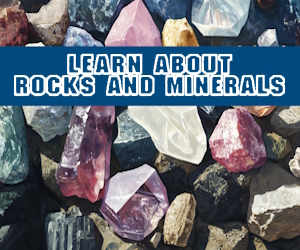English
Castellano
Català
Bonanza at the Red Cloud Mine
Author: Wendell E. Wilson from Volume Twenty-Seven, Number Five
Content by courtesy of : The Mineralogical Record - www.minrec.org
Reproduction of text and photos prohibited without permission of author.
The world's most famous wulfenite occurrence is again yielding specimens, this time in unprecedented quantities. The current operation, however, may eventually mean the end of this classic locality.
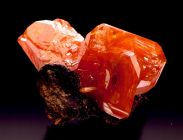
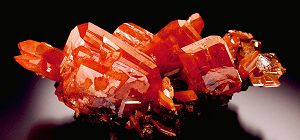
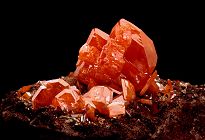
Introduction
Wulfenite from the Red Cloud mine in the Silver district, La Paz County, Arizona, is widely regarded as the world's best because of its stunning red color, in combination with high luster, attractive morphology, good crystal size (to over 5 cm), and transparency. Top quality specimens larger than thumbnail (2.5 cm) or miniature size (5 cm) have traditionally been rare, but specimens have been reaching the market sporadically since Philadelphia mineral dealer A.E. Foote visited the site ca. 1880, and Benjamin Silliman first wrote about it in 1881. For sheer size, beauty, and rose-red color, the specimens found by Ed over in 1938 have been worshipped as the best-of-the-best by wulfenomaniacs worldwide.
History
The Red Cloud mine was first opened as an open cut in the 1860's or 1870's and during the 1880's yielded over $30,000 in lead/silver (at 1880's prices, of course... about $1 per ounce of silver). By 1890 this production is thought to have reached $1 million, by which time the workings had reached approximately the extent at which they stand today, save for the minor burrowings of collectors since then. The history of the claim in recent years has been complex, but in 1995 a group headed by Wayne Thompson (including Les Presmyk, Graham Sutton, Bob Johnson and others) obtained clear ownership of the patented claim.
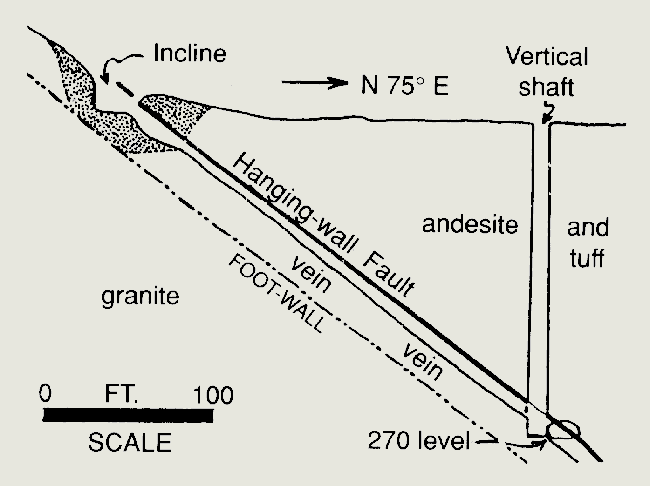
Vertical section view through the Red Cloud mine perpendicular to the vein, showing the inclined shaft and new workings (shaded) (modified from Wilson et al., 1951).
Geology
The Red Cloud fault is bounded on the hanging wall by andesite and on the footwall by monzonite. Between these walls the vein matter composed of mineralized, brecciated andesite, varies in thickness from about 7 to 11 meters. Wulfenite is found lining vugs and fracture surfaces throughout the workings.
The rock of the Red Cloud vein gives no indication when a wulfenite pocket is near; so, for more than a century, collectors have gone underground and dug in places chosen more or less at random, hoping to luck into a crystal lined vug or fracture. Because the potentially productive volume of the vein measures at least 5 to 6 meters thick by 100 meters down-dip and 100 meters along strike, there were originally at least 50,000 cubic meters of potentially productive ground.
As it turns out, however, the vein may actually be up to 11 meters thick, but only the 2 or 3 meters directly adjacent to the hanging wall were stoped by the early miners. This probably means that the pods of argentiferous galena were preferentially situated near the hanging wall. However, wulfenite mineralization appears to permeate all the way up to the footwall (the most recently found pocket ended right at the footwall). Based on this finding, the productive volume may well have exceeded 100,000 cubic meters, less than a quarter of which has already been mined.
Current Operation
Wayne Thompson, and his associates (1723 E. Winter Dr., Phoenix, AZ. 85020; tel 620-678-0156) have been engaged in a major specimen-mining operation at the Red Cloud mine. The mine, incidentally, is situated on the same fault as the North Geronimo mine featured elsewhere in this issue. The new operation at the Red Cloud began in January of 1996.
Rather than contribute further to the honeycomb of underground stopes, passages and crawlways, Thompson's group has decided to mine the entire volume of the vein, from hangingwall to footwall, in horizontal strips beginning at the surface. This eliminates to some extent the luck factor in that, if a pocket exists in that layer, they will find it. The only question is whether they will find enough in each strip to pay for the increasing cost of overburden removal to expose the next few meters of vein. So far they've done well, and are now down 10 meters along the fault from the surface (early miners stripped the first 4 meters of the vein before resorting instead to stoping in selected areas.).
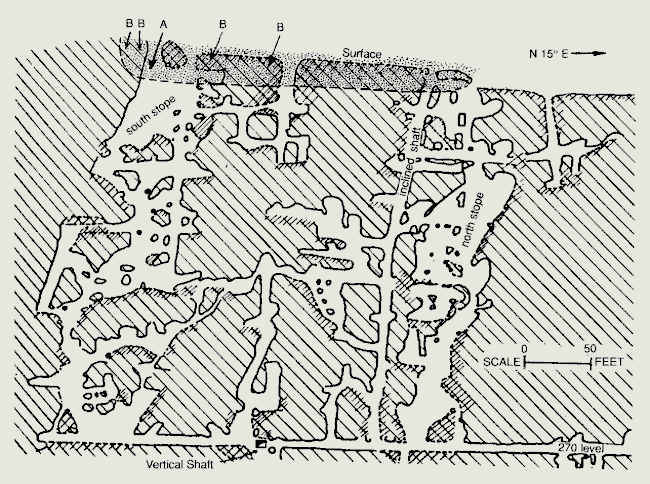
A section along the plane of the vein showing early workings in the Red Cloud mine, and also the area removed by the current operation (stipled). Ore was originally concentrated in two parallel zones (the south stope and the north stope); it remains to be seen how much wulfenite mineralization exists in the relatively unmined area between them. (Modified from Wilson, 1933.) A = large pocket of April 1996; B = smaller pockets.
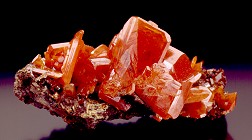
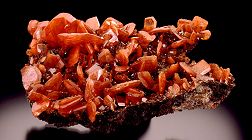
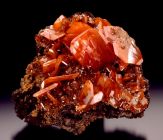
In April 1996 they hit their biggest strike so far: a crystal-lined open vein 10 cm wide, and 1 by 4 meters across! From that one pocket they have recovered large quantities of lower-grade material plus dozens of exceptional specimens from miniature to large cabinet size. Particularly amazing are the large cabinet specimens which are unlike anything ever removed from the Red Cloud mine. This success will finance the next stripping phase; with continued discoveries they hope eventually to remove the entire vein for at least 50 meters down-dip by this open-pit method. From there down, based on what they have learned about wulfenite distribution, they will stope only the potentially richest areas.
So far, despite the large number of superb specimens recovered with crystals well over an inch, nothing found has equaled the 2-inch-plus size of the best Ed Over crystals. Nevertheless, the material taken out so far (as the accompanying photos show) is clearly among the finest other than the few Over pieces, and the sheer quantity is unprecedented.
When the operation ceases, that is, when they can no longer afford to go deeper, government regulations will force them to fill in the pit, sealing whatever remains at a depth relatively inaccessible to future collecting. The pit is expected to take in the vertical shaft which now provides access to the lower reaches of the vein, so even that route of approach will probably be gone. At that point the mine will be quite effectively closed for the foreseeable future. Consequently we can only hope the operation will remain profitable as long as possible, so that the maximum number of specimens can be recovered.
Acknowledgements
All specimens shown here are from the April 1996 pocket; many are now in private collections. All the photos are by Jeffrey A. Scovil, provided to the Mineralogical Record courtesy of Wayne Thompson. (Sizes indicated are maximum dimensions of the specimen as a whole).
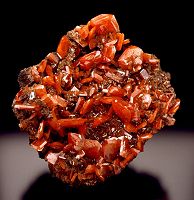
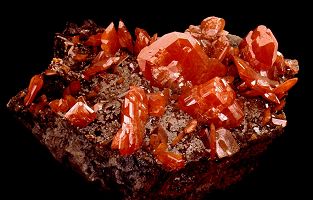
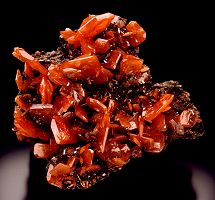
Bibliography
- BANCROFT, P. (1984) Red Cloud mine, Trigo Mtns., Arizona, in:Gem and Mineral Treasures. Western Enterprises, Fallbrook, and Mineralogical Record, Tucson. p 70-73.
- BANCROFT, P. and BRICKER, G. (1990) Arizona's Silver mining district. Mineralogical Record, 21, 151-168.
- EDSON, G.M. (1980) Famous mineral localities: The Red Cloud mine, Yuma County, Arizona Mineralogical Record, 11, 141-152.
- MOORE, T.P. (1996) Tucson Show 1996, in What's new in minerals, Mineralogical Record, 27, 213-214.
- SILLMAN, B. (1881) Vanadinite and other vanadates, wulfenite, crocoite vauquelinite, etc. from Arizona. American Journal of Science, 22, 198.
- SZENICS, T. (1975) Ed Over at the Red Cloud:the story of one man's discovery. Mineralogical Record, 6, 176-179.
- WILSON, E.D. (1933) The geology and mineral deposits of southern Yuma County, Arizona Bureau of Mines Bulletin 134, 65-67.
- WILSON, E.D. (1951) Arizona lead and zinc deposits. Arizona Bureau of Mines Bulletin 158, 90-93.
- WILSON, W.E. (1985) Red Cloud Wulfenite in What's new in minerals? Mineralogical Record 16, 497-499.
Content by courtesy of :

Information | Mineral photos | VIDEOS | Articles | Fairs | Web directory | Classified ads | Minerals Books | Shop



